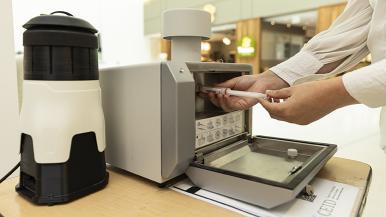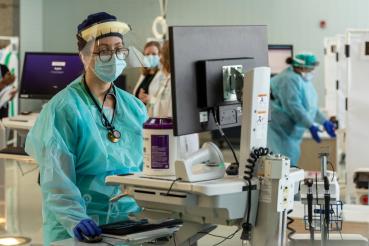What if you could stop germs at the door? Or know within minutes if a virus was in the air?
Scientists at Rush are researching a tool that detects germs in the air, even as they enter a building or gathering spot. It’s one of the ongoing efforts to discover ways to protect the public from infectious diseases.
Hannah Barbian, PhD, is a genomic epidemiologist — a scientific detective whose arsenal includes genomic sequencing of the evidence, i.e. germs that are known to be circulating and those that may be a surprise.
Barbian analyzes germs, mapping their genomic makeup, investigating outbreaks and searching for emerging viral and bacterial threats at the Regional Innovative Public Health Laboratory at Rush. She identifies and tracks COVID-19 variants for the Chicago Department of Public Health by analyzing samples shared by area hospitals. Such surveillance has been an important part of the local and national public health response since the pandemic.
While current surveillance programs track the strains of respiratory viruses and bacteria in available patient samples, the aerosol technology pinpoints what pathogens are inside a building, on a room-by-room basis.
Barbian’s work inspired her to investigate what sampling the air could achieve, how precise it could be and how quickly and easily it could detect pathogens at specific locations.
So far, so good
Getting air samples is easy, which means this method could potentially provide real-time room-level surveillance of germs quickly and simply, she said.
Barbian set up an air sampler, a 13-inch by 14-inch box, about the size of a desktop printer, in four places at Rush University Medical Center: two in the emergency department, one in a lobby and the fourth near a hospital entrance. In collaboration with the Chicago Department of Public Health, air sampling devices also have been placed in six additional locations across Chicago to test how air sampling can complement existing disease surveillance methods. The sampling is part of the RIPHL’s work performing pathogen genome surveillance.
“It can capture air from a large room and, if strategically placed, say at an entrance point or a shared lunch area, it can gather infectious disease data for a building’s occupants,” she said.
Barbian’s research into the new technology began as a pilot project for the Rush Center for Emerging Infectious Diseases, which chose eight projects designed to enhance infectious disease research and community preparedness in Chicago.
The Aerosol Sense sampling device collects air from all directions continuously in a designated area. Testing of the air samples can be done in as little time as an hour and a half.
Barbian is looking for known respiratory viruses and bacteria while also studying what else is in the air. To detect new microbes, Barbian runs a process called metagenomic sequencing, which studies the genomic make up of whatever pathogen might be found in the samples.
“Our preliminary data suggest that a large number of human bacteria and viruses can be seen in air samples,” she said.
Finding new pathogens
In addition, the study is testing the air for eight types of respiratory viruses and bacteria that are known to be of concern, such as flu. The findings of the air samples align with what is found through traditional clinical surveillance, she said. Even the COVID-19 virus detected in the air matches the lineages detected in clinical samples collected about the same time.
Based on what she’s found so far, air sampling could identify the presence of a wide range of germs while also enhancing current surveillance methods that analyze wastewater and clinical samples for specific viruses, she said.
“It is easier to acquire air samples, and the technology provides more focused, finer-scale results than wastewater,” Barbian said. “And it requires less coordination than clinical sampling.”
While the air contains the genetic material from many types of germs, their presence should not worry people in the tested areas. The device identifies miniscule amounts of a virus and detection does not necessarily indicate live or transmissible virus.




